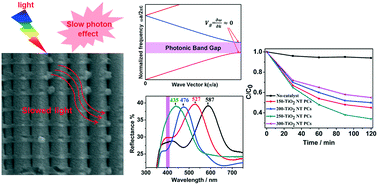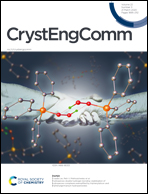Bandgap engineering of TiO2 nanotube photonic crystals for enhancement of photocatalytic capability†
Abstract
The slow photon effect can significantly increase the effective optical path length of light and thereby enhance the interaction of light with matter, which would be realized by light propagating at the edges of the photonic band gap (PBG) in photonic crystals (PCs). In this paper, a novel anodic oxidation method with effective voltage-pulse compensation was developed to prepare one-dimensional titania nanotube photonic crystals (1D TiO2 NT PCs) with a high quality of PBG, which could be continuously adjusted and precisely tailored just by modulating the anodization parameters. With the increase of low voltage (Lv) duration, the precise blue shift of the PBG of 1D TiO2 NT PCs was recorded. Through the precise tailoring of PBG in bandgap engineering, the edges of the PBG could be designed and purposely tuned to overlap with the electronic band gap range of the TiO2 material, and the as-prepared 1D TiO2 NT PCs were used as a photocatalyst to degrade methyl orange (MO) molecules due to the enhanced slow photon effect and scattering effect in their highly ordered channel structures. Meanwhile, strategies to enhance the slow photon effect at the edge of the PBG were discussed and evaluated in detail according to our experimental and simulated results. This study would provide a new guide to taking advantage of the slow photon effect to enhance the photocatalytic activities, photoluminescence, and performances of other optoelectronic devices.



 Please wait while we load your content...
Please wait while we load your content...